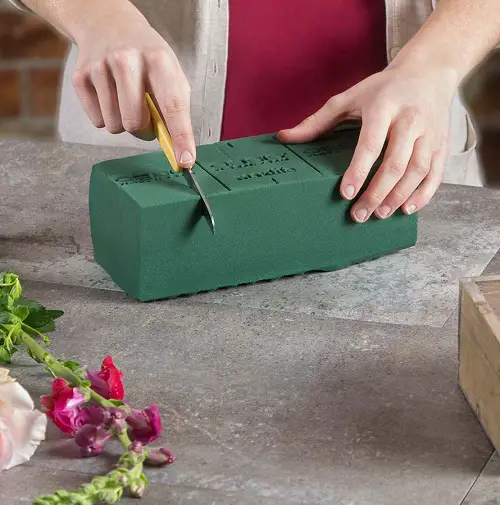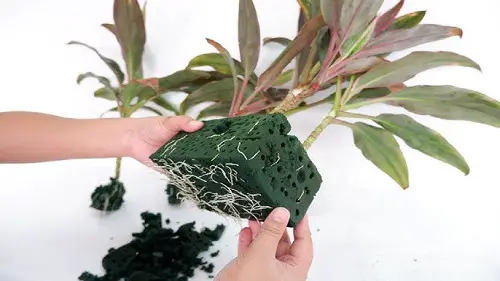Propagate any plant cutting quickly using this trick and have a better success rate than ever before.

If you are looking forward to increasing your chances of growing plants from cuttings by a huge margin, then follow this plant propagation trick!
What’s the Trick?
We’ve uncovered a simple yet genius trick that guarantees success. Forget about complicated setups and expensive tools. This method is so easy that you’ll wonder why you didn’t think of it sooner.
With just a few common household items and the secret–a foam strip, you’ll be a plant propagation pro in no time.
Why foam? Well, foam absorbs water and keeps your propagating plants hydrated, helping them root properly and faster. It also holds the cuttings in one place so they won’t topple. But that’s not all; the foam’s porous structure allows for good air circulation around the cutting, which is essential for root development.
Propagate Any Plant Cutting Quickly Using this Trick

Things You’ll Need
- Sharp, clean pair of scissors or pruning shears
- A strip of foam (such as florist foam)
- Clear glass or pot filled with water
Step 1: Choose a Healthy Plant
This trick works best on vining plants and the ones that love moist growing mediums, so you can use it to propagate plants like Pothos, Philodendron, English ivy, Sweet potato vine, Arrowhead vine, Hoya (Wax plant), Wandering Jew (Tradescantia), Grapevine, Jasmine, Passionflower, Clematis, Trumpet vine, Bougainvillea, Mandevilla, Cordyline and Boston ivy. That doesn’t mean it’s limited to such plants. You can try it on every cutting you pick!
Step 2: Cut 4-6 Inch Long Cuttings
Selecting a healthy parent plant is crucial for successful propagation. Look for plants with vibrant growth, free from pests and diseases, to ensure your cuttings inherit these desirable traits. Choose a healthy, non-flowering stem with multiple nodes for your cutting. The cutting should be firm and vibrant green.
The ideal length of a cutting can vary depending on the plant species. Generally, a cutting of 4-6 inches is a good starting point. Cutting just below a node maximizes the potential for root development, so cut here. The node is the point on the stem where leaves grow, containing hormones that stimulate root growth.
Step 3: Prepare the Foam Strip
The foam strip provides a stable and secure base for the cutting, preventing it from toppling over and damaging the developing roots. Cut a strip of foam long enough to secure the bottom of the cutting. A 2-inch broad and 5-6 inches long foam strip would do. Tuck the cutting’s bottom in the foam strip and wrap it around the stem.
If you have a block of florist foam, you can also cut it into many square pieces and poke the cuttings into each one.
Step 4: Fill a Cup or Glass with Water
Now, you can do one of two things: Either keep the foams with cuttings on a shallow tray or big seed cells and water them when you notice some dryness.
Or, place the foam strip in a glass, cup, or vase (any container that holds water) and fill it with distilled water in a way that a shallow level of water is maintained so that the foam can absorb water to provide consistent moisture to cuttings.
Choose a transparent container, as this allows you to easily monitor root development and detect any signs of rot or disease.
Also, distilled water is preferred for propagation as it lacks the minerals and impurities found in tap water, which can harm the cutting.
Step 5: Provide the Right Growing Conditions
Place your cutting in a location with bright, indirect light. Avoid direct sunlight, as it can cause the leaves to burn and hinder root development. To prevent algae growth, which can compete with the cutting for nutrients, you can try adding a small piece of activated charcoal to the water.
Pro Tip: Maintaining high humidity around the cutting can encourage faster root growth.
Step 6: Wait for Roots to Grow

After a few weeks, you should start to see roots growing from the bottom of the foam. Once the roots are at least an inch long, you can remove the foam strip and place the stem in the soil to continue growing!
For more details, watch the quick video tutorial here
That’s pretty much it! Who knew that a small piece of foam could do such wonders for propagating plants? Do let us know your thoughts and experience in the comment section!



Can you please share what kind of foam is being used in the video?
Thank you!